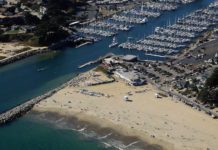
Traffic.
Probably the biggest source of aggravation, complaints, headaches, car repairs, and debates among residents of Santa Cruz County is that one word: traffic.
While all these traffic headaches are roiling here on the ground, there is another traffic problem – and another debate – going on over our heads. Thousands of feet over our heads.
Air traffic.
Specifically, the route that thousands of commercial jets carrying tens of thousands of passengers take to fly into San Francisco International Airport.
Jet noise is a huge, window-rattling problem for people who live in Palo Alto, Los Altos, San Mateo and all other cities on the San Francisco Peninsula.
For some people who moved to the Santa Cruz Mountains in search of clean air and peace and quiet, jet noise also is a problem, a growing problem, and two citizens groups are involved in aggressive campaigns to influence the Federal Aviation Administration as it evaluates its decision implemented in March 2015 to fly a new route slightly farther east than a previous route.
This growing debate is pitting mountain dweller against mountain dweller.
The route change has been paired with a change in the way planes are flying and a major shift toward more instrument-guided landing patterns. Eventually, the FAA says this will mean quieter and safer descents.
In the interim, planes are flying lower and making more noise.
The nicknames for the routes are: SURFER for the current eastern route, and BIG SUR for the previous route, over the San Lorenzo Valley.
This has been a source of confusion for locals, because the “BIG SUR” route has nothing to do with Big Sur, and is west, not east of the current route.
Residents under the SERFR (SURFER) route want the flight moved west, back to the old BSR (BIG SUR) route.
Leaders of the local opposition to that notion are a couple of heavy hitters: the president of the San Lorenzo Valley Chamber of Commerce, Mary Andersen, who also has the support of the powerful Valley Women’s Club; and San Lorenzo Valley School Board member George Wylie, who also happens to be a retired United Airlines pilot who actually has flown on the route under discussion.
“The notion of ‘moving it back’ to the old ‘BIG SUR’ ground track is fundamentally flawed,” Andersen said, because of the lower altitudes in the new jet approaches. She has gathered more than 1,000 signatures on a petition to keep the flight path east of her valley.
“This is a regional issue that affects about 50,000 Santa Cruz County residents in the San Lorenzo Valley, Scotts Valley, Pasatiempo and Bonny Doon areas,” she wrote on Google +.
She said she fears that the FAA might accept a plan to move the flight path “back to our area without the knowledge, input, or consent of the potentially effected neighborhoods.”
“This has been one of the more frustrating processes I’ve been involved with in my public service life,” Santa Cruz County Supervisor Bruce McPherson said this week
McPherson is a member of a Select Committee of elected officials in communities along the flight patch to SFO that has been asked by the FAA to try and reach a consensus recommendation on how it can modify not only the flight path but flying patterns – speed and altitude – to ease the noise strain on everyone along the inbound SFO route.
McPherson now believes that task of making specific recommendations has been nearly impossible for him, because the debate splits his Fifth District constituents.
“Twelve elected officials from three counties who have little aerospace expertise have been tasked with making a recommendation to the Federal Aviation Commission to correct a horrific FAA decision in March 2015 on flight patterns that has impacted the quiet life of thousands of residents in the region.”
McPherson is the only member whose constituency includes the San Lorenzo Valley and Scotts Valley. Scotts Valley Mayor Donna Lind is an alternate.
Chair of the group is Santa Clara County Supervisor Joe Simitian, whose district includes Cupertino, Los Altos, Los Altos Hills, Mountain View, Palo Alto, Saratoga, Stanford, and portions of Sunnyvale and San Jose – basically the noiser, lower-altitude portion of the flight paths into SFO.
Simitian will be making a recommendation – some kind of recommendation – to the FAA at the close of the Select Committee’s meeting today, Oct. 21.
McPherson predicted earlier this week that there won’t be a consensus – defined by the FAA as eight of 12 committee members.
“I don’t sense that the required threshold of at least eight members of the 12-member select committee has reached consensus,” he said.
He said groups have been told they have until Oct. 27 to deliver public comment on the Simitian’s report, following by a final recommendation on Nov. 17. The final decision on any flight path change is to be made by the FAA.
“I believe agreement on a suggested general overview of what can be accomplished holds promise” he said.
The group that made the most noise, which convinced Rep. Sam Farr (whose congressional district includes the Santa Cruz) to get the FAA to create the Select Committee to hear what the public thinks of its 2015 route change, calls itself Quiet Skies.
But its opponents – most of whom live in the San Lorenzo Valley and Scotts Valley – say that what is “quiet” depends on where you live.












